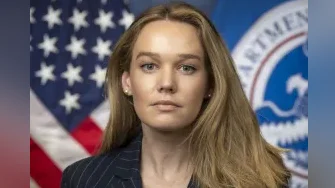The Congressional Record is a unique source of public documentation. It started in 1873, documenting nearly all the major and minor policies being discussed and debated.
“BIOMETRIC ENHANCEMENT FOR AIRPORT-RISK REDUCTION ACT OF 2008” mentioning the U.S. Dept. of Energy was published in the House of Representatives section on pages H5496-H5498 on June 18, 2008.
The publication is reproduced in full below:
BIOMETRIC ENHANCEMENT FOR AIRPORT-RISK REDUCTION ACT OF 2008
Mr. THOMPSON of Mississippi. Mr. Speaker, I move to suspend the rules and pass the bill (H.R. 5982) to direct the Secretary of Homeland Security, for purposes of transportation security, to conduct a study on how airports can transition to uniform, standards-based, and interoperable biometric identifier systems for airport workers with unescorted access to secure or sterile areas of an airport, and for other purposes, as amended.
The Clerk read the title of the bill.
The text of the bill is as follows:
H.R. 5982
Be it enacted by the Senate and House of Representatives of the United States of America in Congress assembled,
SECTION 1. SHORT TITLE.
This Act may be cited as the ``Biometric Enhancement for Airport-Risk Reduction Act of 2008''.
SEC. 2. DEFINITIONS.
In this Act, the following definitions apply:
(1) Biometric identifier system.--The term ``biometric identifier system'' means a system that uses biometric identifier information to match individuals and confirm identity for transportation security and other purposes.
(2) Secretary.--The term ``Secretary'' means the Secretary of Homeland Security acting through the Assistant Secretary of Homeland Security (Transportation Security Administration).
SEC. 3. BIOMETRIC IDENTIFIER SYSTEMS.
(a) Study.--
(1) In general.--The Secretary, in consultation with the working group of industry stakeholders to be established under subsection (c), shall conduct a study on how airports can transition to uniform, standards-based, and interoperable biometric identifier systems for airport workers with unescorted access to secure or sterile areas of an airport.
(2) Purpose.--The purpose of the study shall be to enhance transportation security against a potential act of terrorism by an airport worker who is allowed unescorted access to secure or sterile areas of an airport.
(3) Risk-based analysis.--In conducting the study, the Secretary shall conduct a risk-based analysis of selected Category X and I airports and other airports, as the Secretary determines appropriate, to identify where the implementation of biometric identifier systems could benefit airports.
(4) Considerations.--In conducting the study, the Secretary shall consider the following:
(A) Parallel systems.--Existing parallel biometric security systems applicable to workers with unescorted access to critical infrastructure, including--
(i) transportation security cards issued under section 70105 of title 46, United States Code;
(ii) armed law enforcement travel credentials issued under section 44903(h)(6) of title 49, United States Code; and
(iii) other credential programs used by the Federal Government, as the Secretary considers appropriate.
(B) Efforts by transportation security administration.--Any biometric programs or proposals developed by the Assistant Secretary of Homeland Security (Transportation Security Administration).
(C) Infrastructure and technical requirements.--The architecture, modules, interfaces, and transmission of data needed to address risks associated with securing airports by providing interoperable biometric security measures and credentials for airport workers with unescorted access to secure and sterile areas of an airport.
(D) Existing airport systems.--Biometric infrastructure and systems in use in secure and sterile areas of airports.
(E) Incentives.--Possible incentives for airports that voluntarily seek to implement uniform, standards-based, and interoperable biometric identifier systems.
(F) Associated costs.--The costs of implementing uniform, standards-based, and interoperable biometric identifier systems at airports, including--
(i) the costs to airport operators, airport workers, air carriers, and other aviation industry stakeholders; and
(ii) the costs associated with ongoing operations and maintenance and modifications and enhancements needed to support changes in physical and electronic infrastructure.
(G) GAO recommendations.--Any recommendations or findings developed by the Government Accountability Office relating to implementing biometric security for airport workers with unescorted access to secure and sterile areas of airports.
(H) Information from other sources.--Recommendations, guidance, and information from other sources, including government entities, organizations representing airport workers, and private individuals and organizations.
(5) Report.--Not later than 270 days after the date of enactment of this Act, the Secretary shall submit to the Committee on Homeland Security of the House of Representatives and the Committee on Commerce, Science, and Transportation of the Senate a report on the results of the study conducted under this subsection.
(b) Best Practices.--
(1) Identification of best practices.--The Secretary, in consultation with the working group of aviation industry stakeholders to be established under subsection (c), shall identify best practices for the administration of biometric credentials at airports, including best practices for each of the following processes:
(A) Registration and enrollment.
(B) Eligibility vetting and risk assessment.
(C) Issuance.
(D) Verification and use.
(E) Expiration and revocation.
(F) Development of a cost structure for acquisition of biometric credentials.
(G) Development of redress processes for workers.
(2) Report.--Not later than one year after the date of enactment of this Act, the Secretary shall--
(A) submit to the Committee on Homeland Security of the House of Representatives and the Committee on Commerce, Science, and Transportation of the Senate a report that outlines the best practices identified under paragraph (1); and
(B) make the report available to airport operators.
(c) Aviation and Airport Security Working Group.--
(1) In general.--The Secretary shall convene a working group to assist the Secretary with issues pertaining to implementing and carrying out this section.
(2) Membership.--The Secretary shall ensure that the membership of the working group includes aviation industry stakeholders and specifically includes individuals selected from among--
(A) the membership of the Transportation Security Administration's Aviation Security Advisory Committee;
(B) individuals and organizations representing airports;
(C) individuals and organizations representing airport workers, including those airport workers with unescorted access to secure and sterile areas of airports;
(D) individuals and organizations representing the biometric technology sector; and
(E) any other individuals and organizations that the Secretary considers appropriate.
(3) Nonapplicability of faca.--The Federal Advisory Committee Act (5 U.S.C. App.) shall not apply to working group established under this subsection.
(4) Sunset.--The working group established under this subsection shall cease operations 30 days after the date of submission of the report under subsection (a)(5) or 30 days after the date of submission of the report under subsection
(b)(2), whichever is later.
The SPEAKER pro tempore. Pursuant to the rule, the gentleman from Mississippi (Mr. Thompson) and the gentleman from California (Mr. Daniel E. Lungren) each will control 20 minutes.
The Chair recognizes the gentleman from Mississippi.
General Leave
Mr. THOMPSON of Mississippi. Mr. Speaker, I ask unanimous consent that all Members may have 5 legislative days to revise and extend their remarks and include extraneous material on the bill under consideration.
The SPEAKER pro tempore. Is there objection to the request of the gentleman from Mississippi?
There was no objection.
Mr. THOMPSON of Mississippi. Mr. Speaker, I rise in strong support of this bill and yield myself such time as I may consume.
Mr. Speaker, last month I introduced H.R. 5982, the Biometric Enhancement for Airport Risk Reduction Act of 2008, also known as the BEAR Act. The bill was marked up and adopted unanimously by the House Committee on Homeland Security on May 20.
The Transportation Security Administration is responsible for securing 450 U.S. airports and employs approximately 50,000 people. It has a very important mission of keeping the traveling public safe from terrorist threats. But the question remains, what is TSA doing to increase security and still allow workers with unescorted access to sterile and secure areas of airports? And what mechanisms are in place to ensure that only the employees are allowed to access the airports' secure and sterile areas.
The BEAR Act addresses these concerns. It requires TSA to provide Congress and airport operators with a report on best practices for using biometrics at airports.
Last November, Federal law enforcement raided Chicago's O'Hare Airport and arrested 23 people for fraudulently securing badges that gave them unescorted access to sensitive airport locations. According to the charging affidavit, more than 100 temporary workers were found to be in possession of fraudulent badges. And the investigation revealed that the staffing agency that sponsored these workers told them that they needed identification, but it did not have to be legitimate.
Today, workers with unescorted access to these critical facilities go through background screening to get identification badges. This background screening includes checking against a terrorist watch list. While this is a necessary and important check, a worker's biometrics are not being captured in check against biographic information to establish the individual's identity.
Since the Chicago incident, there has been a growing international trend to incorporate biometric identifying credentials in airport IDs. Canada and the United Kingdom have already taken action to address the security risk at airports by using biometric identifying credentials for airport workers.
Although I recognize the ongoing work that TSA has been doing in the last year or so, it's time for them to consider moving forward. The BEAR Act will make this happen.
The bill promotes collaboration between TSA industry, labor, and other stakeholders to collectively develop and provide airports with a blueprint on how to make biometrics work for them. The BEAR Act, as amended, includes changes proposed by my colleagues on the other side of the aisle and TSA to improve the bill, including clarifying that TSA should only conduct a risk-based study of Category 10 and Category 1 airports on a selected groups of airports, defining uniform biometric identified systems to make sure that TSA looks at systems that actually match individuals, not just cards, that have biometrics on them, recognizing and not tampering with TSA's ongoing efforts in the area of biometrics such as the TWIC program and other programs.
Therefore, Mr. Speaker, I urge my colleagues to support H.R. 5982.
I reserve the balance of my time.
Mr. DANIEL E. LUNGREN of California. Mr. Speaker, I rise in support of H.R. 5982. As a Californian, the State that was once known as the Bear Republic, and proud resident of the State of California, which has the bear flag, I rise in support of the BEAR bill that the gentleman from Mississippi has introduced and brought to the floor today.
{time} 1115
The chairman from Mississippi has brought us a bill that seeks to build on work that has already been done in previous Congresses and also with TSA, but I think he gives us a little bit of a push to move in the direction of biometrics.
The Biometric Enhancement for Airport-Risk Reduction Act simply recognizes that as we go forward in trying to secure our airports and the flying public and the cargo from terrorist attack we need to use those things which give us an advantage over those who would do harm to us, and that means we need to have the smart use of technology.
The gentleman from Mississippi has been one of those who has spoken for several years about the fact that we need to get biometrics on board more quickly than we have, and I join the gentleman in that hope. I think this bill will move us in that direction.
People should understand that biometrics merely refers to identifiers. They could be something as simple as fingerprints. They could be iris scans, things of that sort, some medium by which we are able to identify an individual with the documentation that they have. And then if you have readers that are all over the landscape now for various different enterprises, it allows you in an economical and in an efficient way to identify the individuals that are granted access to particular areas, and this is particularly important when we're talking about vast areas that we find at airports.
Airports are not severely confined by geography as are some other enterprises, some other commercial enterprises, where you might be able to more easily secure the area. Particularly when you have airports where you have individuals who are cleared to work there, moving in and out, in and out, in and out of areas which are supposed to be secured areas, you have to find a reasonably efficient means that is also an effective means of identifying those people who should be in those areas and those people who should not be in those areas.
And that is why biometric technology presents such an opportunity for us, and for these and other reasons I would support H.R. 5982.
At this time, I reserve the balance of my time.
Mr. THOMPSON of Mississippi. Mr. Speaker, I yield 3 minutes to the distinguished gentlewoman from Texas (Ms. Jackson-Lee).
Ms. JACKSON-LEE of Texas. I thank the distinguished gentleman from Mississippi, the chairman of the committee, and I want to thank him and applaud him for this legislation.
As has been indicated on the floor, the importance of ensuring the security and the sanctity of the particular identification, the technology, is key. One of the key problems that we have found in homeland security is, of course, the ability to tamper with the security document or the process. This legislation is an important, enhanced effort to ensure that that does not happen.
I want to thank the chairman for his leadership on this particular issue, and also, I think it's important to note that one of the commitments that homeland security has made is, ``Not on our watch,'' and we have steadfastly looked at all of the elements that need to be improved and enhanced in border security and aviation security to ensure that there are documents that can be, on their face, the kind of document that provides the necessary review and protection for the traveling public and for those who do business in the ports of America.
Mr. Speaker, I rise today in strong support of H.R. 5982, the Biometric Enhancement Act for Airport-Risk Reduction Act of 2008, introduced by my distinguished colleague from Mississippi, Chairman Thompson. This important legislation requires TSA to provide Congress and airport operators with a breakdown on best practices for utilizing biometrics to better protect airports.
In the last few months, the Transportation Security Administration, TSA, has unveiled several new programs and initiatives that are proving to build a ``layered approach'' to security. And while the TSA is responsible for the 450 U.S. airports, and employs approximately 50,000, with the very important mission of keeping the traveling public safe from terrorist threats, it has done very little to strengthen airport security for workers with unescorted access to sterile and secure areas of the airport. At the present time, there are few mechanisms in place to ensure that contracted employees follow due diligence at our airports and access is granted to only those employees who belong on airport grounds at any given time. This legislation addresses these key issues by requiring TSA to provide Congress and airport operators with a breakdown on best practices for utilizing biometrics to better protect airports.
Mr. Speaker, only last November, Federal law enforcement raided Chicago's O'Hare International Airport in November 2007 and arrested 23 people for fraudulently securing badges to gain access to sensitive airport locations. According to the charging affidavit, more than 100 temporary workers were found to be in possession of the fraudulent badges and the staffing agency that sponsored these workers told them that they needed identification, but such identification did not have to be legitimate.
While today's workers with unescorted access to this critical infrastructure go through background screening, which includes terror watch list checks, to get issued badges, more must be done. While this is a necessary and important check, a job applicant's biometrics are not being captured to check against biographic information provided to establish the individual's identity. The legislation we have before us today is a smart security approach that promotes collaboration between TSA, industry, labor and other key stakeholders to work together to collectively develop and provide airports with a blueprint on how to make biometrics work for them.
Mr. Speaker, this legislation requires TSA to study how airports can transition to uniform, standards-based and interoperable biometric identifier systems for airport workers with unescorted access. This bill furthermore requires TSA and the working group to examine existing programs, such as TWIC, and identify approaches on how biometrics can enhance protections for secure and sterile areas of the airport. TSA is also required by this bill to provide Congress and airport operators with a breakdown on best practices for using biometrics to improve airport security.
Mr. Speaker, this bill is not about re-inventing the wheel or putting a stop to any good work at TSA on this issue. It is about encouraging public-private partnerships and promoting an open dialogue between TSA, industry, and Congress on how best to secure our airports. I am proud to support this important and timely legislation, and I encourage my colleagues to join me in so doing.
Mr. DANIEL E. LUNGREN of California. I reserve the balance of my time.
Mr. THOMPSON of Mississippi. Mr. Speaker, I yield 1 minute to the gentlewoman from New York (Mrs. Lowey).
Mrs. LOWEY. I wanted to rise to thank our chairman for your important work on this issue. We have worked together on 100 percent screening of workers at airports, and now, there is a pilot project in place for seven of those airports, and we know that in three they are doing 100 percent screening. And at the others, they're looking at other methods, and one of the methods that they are seriously considering and some are using are the issue of biometrics because it is so important.
So I do want to thank the chairman for your leadership on this issue, and I look forward to following the work of the seven airports. Hopefully, we'll be able to spread it to all of our airports.
Mr. DANIEL E. LUNGREN of California. Mr. Speaker, again, in closing, I rise in support of H.R. 5982, the BEAR Act, the Biometric Enhancement for Airport-Risk Reduction Act, brought to us by the chairman of this committee. This is an advancement. This is a push to where we need to go with respect to biometrics.
We ought to understand that the United States is the leader in the world in technology and technology application. We need to do that here as well. And it sometimes seems strange that we don't take advantage of the leadership that we have in applying it to certain areas. The urgency that we need to adopt with respect to the threat that is out there is, I think, shared by this committee, but I'm not sure that it is shared totally by the full Congress, nor by the Federal establishment all together nor, in some cases, by the American people, where, after our successes in forestalling any major terrorist attack on our shores since 9/11, it allows us a certain relaxation that I think is dangerous. The gentleman moves us in the right direction with this bill.
I might say that as we move with this bill I would hope we would move with some other bills on this floor dealing with the threat that we have to our national economy and our national security through our energy dependence on many, many others.
The U.S. is the leader in the potential for oil shale, just as we're the leader in technology in this world. The U.S. might be called the Saudi Arabia of oil shale. According to the Department of Energy, this Nation is endowed with more than 2 trillion barrels of oil. To put this figure in perspective, the world has used 1 trillion barrels of oil since the first oil well was successfully drilled in Pennsylvania in 1859. According to the Department of Energy, let me repeat, we are endowed with more than 2 trillion barrels of oil, and we're talking about U.S. oil shale.
The problem is that we had a rider on an appropriations bill just last year that makes this huge domestic resource off-limits. That would be as silly as us having a bill on the floor that would say, even though we're the leader in biometric technology, we will prohibit its use in the area of airport security. That would make no sense, Mr. Speaker, nor does it make sense for us not to utilize this tremendous resource we have.
So again, Mr. Speaker, I would say that I would encourage all Members to support H.R. 5982, the Biometric Enhancement for Airport-Risk Reduction Act, otherwise known as the BEAR Act, brought to us on this floor by the distinguished gentleman from Mississippi, the chairman of our committee.
With that, Mr. Speaker, I yield back the balance of my time.
Mr. THOMPSON of Mississippi. Mr. Speaker, I yield myself as much time as I may consume.
Mr. Speaker, I urge all my colleagues to support this commonsense approach to studying how biometrics can be used to improve airport security.
I think it is important to make clear again, this bill does not create any new mandates on airports. This bill does not require airports to use biometric identifying systems. Instead, it only provides for a study of how biometrics could be used.
I strongly believe that strategic deployment of biometrics in the airport is a sensible part of any layered security plan for the airport environment. Therefore, I urge my colleagues to support this important legislation and make our airports safer.
Ms. GINNY BROWN-WAITE of Florida. Mr. Speaker, I rise today in support of H.R. 5982, Chairman Thompson's legislation that would take an important step toward improving airport security.
Since 9/11, Congress and the airline industry have taken strong actions to tighten security at our nation's airports.
These measures have included the creation of the TSA, the expansion of the air marshal service, and the full screening of airline passengers.
Chairman Thompson's proposal before us today would build upon these early efforts by implementing a study on the use of biometrics in identifying airport workers.
As TSA continues to look for ways to ensure that airport workers--in addition to passengers--do not pose security risks, pursuing biometrics is a timely and necessary effort.
At the same time, pursuing biometrics would also enhance efforts to conduct 100 percent screening of airport workers with access to secure parts of an airport.
Congresswoman Nita Lowey and I have long supported 100 percent screening of airport workers.
Earlier in this Congress, we were proud to introduce and pass H.R. 1413, a bill to establish a pilot program to test such worker screening at a number of airports.
Just recently, TSA launched a pilot similar to the program outlined in our bill, and I look forward to learning the results of this important test upon its completion.
Of course, no one wants more bureaucracy for bureaucracy's sake, but Congress needs to look continuously for ways to improve protection for the traveling public.
As 9/11 so painfully taught us, we must resolve our security weaknesses before terrorists exploit the remaining gaps.
I urge my colleagues to support H.R. 5982.
Mr. THOMPSON of Mississippi. Mr. Speaker, I yield back the balance of my time.
The SPEAKER pro tempore. The question is on the motion offered by the gentleman from Mississippi (Mr. Thompson) that the House suspend the rules and pass the bill, H.R. 5982, as amended.
The question was taken; and (two-thirds being in the affirmative) the rules were suspended and the bill, as amended, was passed.
A motion to reconsider was laid on the table.
____________________







